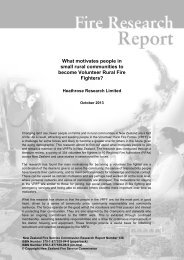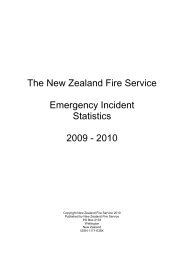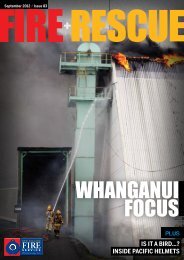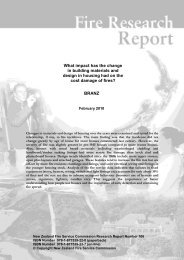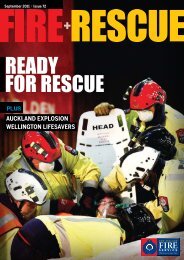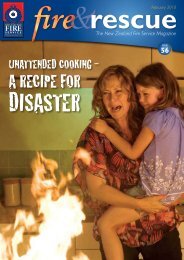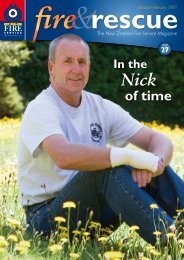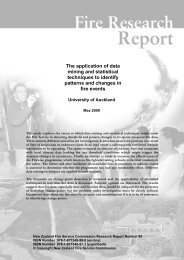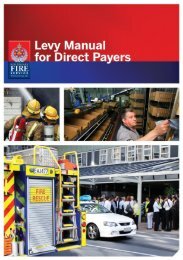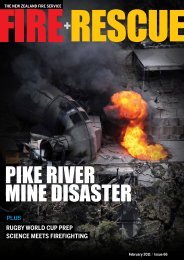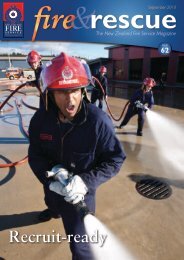Tag teaming for fire safety - New Zealand Fire Service
Tag teaming for fire safety - New Zealand Fire Service
Tag teaming for fire safety - New Zealand Fire Service
You also want an ePaper? Increase the reach of your titles
YUMPU automatically turns print PDFs into web optimized ePapers that Google loves.
October 2009<br />
The <strong>New</strong> <strong>Zealand</strong> <strong>Fire</strong> <strong>Service</strong> Magazine<br />
<strong>Tag</strong> <strong>teaming</strong><br />
<strong>for</strong> <strong>fire</strong> <strong>safety</strong><br />
ISSUE<br />
53
October 2009<br />
Issue No. 53<br />
<strong>Fire</strong> & Rescue is the flagship<br />
publication of the <strong>New</strong> <strong>Zealand</strong><br />
<strong>Fire</strong> <strong>Service</strong>.<br />
It is produced by Media,<br />
Promotions and Communications,<br />
National Headquarters,<br />
Level 9, 80 The Terrace, Wellington.<br />
Front cover: Kiwi Pro Wrestling champion<br />
H-Flame fights <strong>for</strong> <strong>fire</strong> <strong>safety</strong> in the new<br />
television programme “Off the Ropes”.<br />
Back cover: Getting ready to evacuate a<br />
Canadian community threatened by <strong>fire</strong>.<br />
Contributions <strong>for</strong> <strong>Fire</strong> & Rescue<br />
We welcome ideas <strong>for</strong> articles, news<br />
and events that would be of interest to<br />
other <strong>Fire</strong> <strong>Service</strong> staff and volunteers.<br />
Draft articles and photos (pictures<br />
need to be at least 1MB) can be<br />
emailed to <strong>fire</strong>.rescue@<strong>fire</strong>.org.nz or<br />
contact the editor Karlum Lattimore<br />
on 04 496 3702.<br />
Post written material and photos,<br />
or photo CDs to:<br />
<strong>Fire</strong> & Rescue magazine,<br />
PO Box 2133, Wellington.<br />
(These will be returned on request)<br />
<strong>Fire</strong> & Rescue is online at:<br />
www.<strong>fire</strong>.org.nz<br />
ISSN: 1176-6670<br />
All material in <strong>Fire</strong> & Rescue magazine is<br />
copyrighted and may not be reproduced<br />
without the permission of the editor.<br />
4<br />
14<br />
6 11<br />
Dog Tales Spreading the message.....................................................................3<br />
Dog rescuers ...........................................................................................3<br />
<strong>Fire</strong> Safety Grappling to reach the hard to reach ......................................4<br />
Awards Going <strong>for</strong> more gold ............................................................................6<br />
Three of a kind .......................................................................................6<br />
People A couple of minutes with... Paul McGill ....................................7<br />
Equal opportunity <strong>for</strong> 2010 calendars ....................................8<br />
What’s <strong>New</strong> Get <strong>Fire</strong>wise now online ....................................................................9<br />
<strong>New</strong> Personal Protective Equipment on its way ..............10<br />
<strong>New</strong> Commissioners ........................................................................11<br />
Truck Update Building up the fleet ........................................................................12<br />
Rural Change Re-organisation of rural <strong>fire</strong> districts underway ................14<br />
<strong>New</strong> Technology Satellite <strong>for</strong> hazmats ........................................................................15<br />
Research Taking up the challenge .................................................................16<br />
Promotions Northland recruitment drive........................................................17<br />
Out and about ....................................................................................17<br />
Around the World Canada – it’s big big big................................................................18<br />
16<br />
18
Spreading the message<br />
The Clyde brigade can put out <strong>safety</strong><br />
messages as well as they put out a <strong>fire</strong>.<br />
Recently, a young local man decided to have a late night<br />
fry-up but fell asleep while the oil was heating. He was<br />
saved from the smoke and flames by the barking of<br />
his dog.<br />
Local <strong>fire</strong> chief Richard Davidson and Queenstownbased<br />
<strong>fire</strong> risk management officer Stuart Ide managed<br />
to draw the media’s attention to three different <strong>safety</strong><br />
messages when the story was reported.<br />
There were no smoke alarms (apart from the bearded<br />
collie dog Jute), never leave cooking unattended and<br />
don’t return to the <strong>fire</strong> once you’re out of the house.<br />
“We were really pleased with the story that was<br />
printed in the Otago Daily Times – it was a great<br />
illustration of just what can happen when you ignore<br />
the <strong>safety</strong> messages we promote across the country.<br />
This young chap is now planning to buy some smoke<br />
alarms and go out <strong>for</strong> takeaways instead of cooking<br />
late at night,” said Richard.<br />
Dog rescuers<br />
Stuart Ide inspects the damage<br />
from the late night fry-up.<br />
Silverdale volunteers Natasha Thompson and Ali Turner turned out to a three-car fatal<br />
crash and went home with a traumatised Springer spaniel.<br />
Dog Tales<br />
“It was very sad. The dog’s elderly owners both died<br />
after the crash and they had no next of kin. We had taken<br />
the dog to our local vet in Silverdale to be checked out<br />
and he immediately recognised him and told us his name<br />
was Guinness. The police offered to take him to the<br />
pound but the vet suggested the dog would be better off<br />
being with people to help him get over the crash. So we<br />
took him to the <strong>fire</strong> station and Guinness ended up<br />
going home with us,” said Natasha.<br />
“He’s a fantastic dog, very cool with a wonderful<br />
personality and just three years old. But sadly, both Ali<br />
and I travel a lot and so we’re just fostering him until<br />
we can find a permanent home <strong>for</strong> him.”<br />
Natasha says there have been 14 people killed on<br />
local roads so far this year compared with just five<br />
last year.<br />
The <strong>New</strong> <strong>Zealand</strong> <strong>Fire</strong> <strong>Service</strong> Magazine October 2009<br />
Photo courtesy of Otago Daily Times<br />
3
<strong>Fire</strong> Safety<br />
Grappling to reach the<br />
hard to reach<br />
4 Issue No. 53<br />
Kiwi Pro Wrestling champion and<br />
<strong>fire</strong> <strong>safety</strong> champion. H-Flame.
By Scott Sargentina<br />
Hands up those who can remember On the Mat, the<br />
iconic Kiwi wrestling show that was required viewing in<br />
the early 1970’s?<br />
Double points if you can recall some of the names that<br />
achieved ‘cult like’ status from the show – King Curtis,<br />
Mark Lewin, Big John Da Silva and Sivi Afi Taogaga.<br />
Those early black and white TV shows filmed be<strong>for</strong>e<br />
small audiences on bench seats in small studios, seem a<br />
far cry from the hype and razzamatazz generated by<br />
the United States WWE pro wrestling circus broadcast<br />
around the world. But they were no less popular.<br />
So why would the <strong>Fire</strong> <strong>Service</strong> be associated on a trial<br />
basis with ‘Off the Ropes’ a 13 part <strong>New</strong> <strong>Zealand</strong><br />
wrestling series starting on Prime TV next month?<br />
Like our association with the Bro Town series early this<br />
year, being part of Off the Ropes is a deliberate move<br />
to connect the <strong>Fire</strong> <strong>Service</strong> with people we know are most<br />
at risk from <strong>fire</strong> but who are hard to reach. These include<br />
the young, Ma - ori, Polynesian, students who flat, and the<br />
unemployed.<br />
The cluttered media landscape<br />
The reasons why some people have become hard to reach<br />
are many and varied. When On the Mat played in the<br />
early 70s, it was shown on the country’s only TV channel.<br />
Back then, conveying a message was relatively simple.<br />
Put it on TV and you could be pretty confident people<br />
would see it. Times have changed and not only have<br />
we seen a dramatic increase in free-to-air television,<br />
but satellite as well. VHS and DVD players gave people<br />
more viewing options and they can record and play<br />
back without watching the ads. With the availability of<br />
MySky and TIVO this will only get more pronounced.<br />
There’s competition <strong>for</strong> our attention from the internet,<br />
numerous radio stations, community newspapers,<br />
letterbox flyers, catalogues and other ‘junk’ mail.<br />
It has been estimated that the average <strong>New</strong> <strong>Zealand</strong>er is<br />
exposed to 1,500 advertising messages on a daily basis.<br />
It’s difficult to cut through all this clutter unless you have<br />
a huge advertising budget.<br />
The <strong>New</strong> <strong>Zealand</strong> <strong>Fire</strong> <strong>Service</strong> does not have this type of<br />
budget, so we need to be smarter with what we do have.<br />
Be part of the programme – not the<br />
ad break<br />
One of the ways we can guarantee our message will<br />
be seen is via in-programme marketing (a.k.a. product<br />
placement) which is extremely effective in communicating<br />
messages to an audience who would normally be distracted<br />
by commercial breaks.<br />
<strong>Fire</strong> Safety<br />
This type of marketing gives us a great opportunity to<br />
promote <strong>fire</strong> <strong>safety</strong> messages as part of the storyline and<br />
in ways that are not bizarre or out-of-place and not in<br />
competition with other advertising.<br />
Our association with ‘Off the Ropes’ gives us the<br />
following benefits:<br />
• H-Flame is the current Kiwi Pro Wrestling champion<br />
and he will be a <strong>Fire</strong> <strong>Service</strong> ‘related’ character. He’s a<br />
good guy who the crowd loves. He fights bad guys<br />
who the crowd hate. Occasionally H-Flame will lose<br />
but only because of some cowardly, underhand action<br />
of the bad guy. H-Flame will enter the stadium in a<br />
Level 2 jacket to the sounds of <strong>fire</strong> truck air horns.<br />
• Off the Ropes is not just about wrestling bouts. There<br />
is also a ‘behind the scenes’ component and this is where<br />
we see examples of inappropriate and acceptable <strong>fire</strong><br />
behaviour which will be demonstrated by the wrestlers<br />
as part of the actual programming. Messages will<br />
cover smoke alarm installation, dangers of unattended<br />
cooking and overloaded plugs, keeping things a metre<br />
from the heater.<br />
There is an old saying “If you do what you’ve always<br />
done, you’ll get what you’ve always got.” While we<br />
will always have a television advertising presence,<br />
increasingly you will see <strong>Fire</strong> <strong>Service</strong> messages on the<br />
internet, as part of on-demand television, in outdoor<br />
situations, and via communication channels provided<br />
by our partners. However, nothing can replace the<br />
No. 1 method of supplying <strong>fire</strong> <strong>safety</strong> advice to a<br />
captivated audience – our operational crews who do<br />
a sensational job at home shows, A&P shows, school<br />
visits, community events and so on. This activity is<br />
priceless and directly responsible <strong>for</strong> saving lives<br />
and property.<br />
The <strong>New</strong> <strong>Zealand</strong> <strong>Fire</strong> <strong>Service</strong> Magazine October 2009<br />
5
Awards<br />
Going <strong>for</strong> more gold<br />
After picking up his <strong>Fire</strong> <strong>Service</strong> Sportsman of the year<br />
2008 trophy earlier this year, Dennis O’Leary is now<br />
well into his training <strong>for</strong> the NZ <strong>Fire</strong>fighters Masters<br />
Track & Field Championships in Christchurch April<br />
2010. The Hastings <strong>fire</strong>fighter is then off to the World<br />
<strong>Fire</strong>fighters Games in Daegau South Korea in August<br />
that year.<br />
Dennis has been active in <strong>Fire</strong> <strong>Service</strong> sport <strong>for</strong> all of<br />
his 32 years service, especially rugby and waterway<br />
competitions. He’s a past winner of World <strong>Fire</strong>fighter<br />
Games gold and silver medals in track and field<br />
sprint events.<br />
Three of a kind<br />
Three generations of the same Silverdale <strong>Fire</strong> Brigade family received their service awards recently.<br />
Left: son, Daniel Capon (three years service) won<br />
awards <strong>for</strong> most improved <strong>fire</strong>fighter and <strong>for</strong> attending<br />
the most musters (shared with Ben Capstick).<br />
Middle: grandfather, Nigel Capon (33 years) was<br />
awarded his gold bar, and named as the officer who<br />
had attended the most musters.<br />
6 Issue No. 53<br />
Right: father, Trevor Capon (14 years) was awarded<br />
the long service and good conduct medals and also<br />
named as the <strong>Fire</strong> Police member who has attended<br />
most training musters.<br />
Between them, this very committed <strong>fire</strong> brigade<br />
family has racked up 50 years of service to their<br />
community.<br />
Photo Dennis O’Leary
A couple of minutes with...Paul McGill<br />
Where are you stationed<br />
National Headquarters in Wellington.<br />
What’s your title<br />
Director of Operations and Training.<br />
What’s been your progression within<br />
the NZFS over the past 25 years<br />
I joined the <strong>Fire</strong> <strong>Service</strong> in 1980 as a<br />
recruit <strong>fire</strong>fighter in Auckland and served<br />
the next 15 years there as a frontline<br />
operational <strong>fire</strong>fighter and officer. I worked<br />
at eight stations across Auckland and <strong>for</strong><br />
two years was a training instructor based<br />
at Mt Wellington.<br />
I moved to Dunedin in 1995 to take up<br />
the Otago Assistant Area Manager position.<br />
In 1997 I was appointed the Auckland<br />
Area Chief <strong>Fire</strong> Officer and a year later the<br />
Auckland <strong>Fire</strong> Region Manager. In 2005 I<br />
took up my current position in Wellington.<br />
Family<br />
I’m married to Chris and we have three<br />
children, Erin, Mike and Pat. They are in<br />
their 20s and live in Auckland, Dubai<br />
and Perth.<br />
What’s the one thing that sticks in<br />
your mind about the job<br />
How we have brigades in almost every<br />
community in <strong>New</strong> <strong>Zealand</strong> and how well<br />
we reflect and serve those communities.<br />
If you could make one change to the<br />
<strong>Fire</strong> <strong>Service</strong> what would it be<br />
To update our legislation and further<br />
integrate urban and rural service delivery.<br />
Your most embarrassing moment<br />
on the job<br />
Jumping out of bed <strong>for</strong> a <strong>fire</strong>call and<br />
finding one of my legs was completely<br />
asleep. Like a wounded duck I struggled to<br />
get my trou and socks on and stagger<br />
down two <strong>fire</strong> poles to be very much last<br />
to the waiting truck. Not a good look.<br />
The <strong>New</strong> <strong>Zealand</strong> <strong>Fire</strong> <strong>Service</strong> Magazine<br />
What’s one thing people would be<br />
surprised to learn about you<br />
That I once had very long hair, much in<br />
the style of Robert Plant. Prior to the<br />
<strong>Fire</strong> <strong>Service</strong> (and baldness) of course!<br />
Favourite book<br />
Bill Bryson’s “The short history of nearly<br />
everything”.<br />
Favourite movie<br />
Lots of favourites, but one I enjoyed recently<br />
was the unlikely, emotional Japanese film<br />
about morticians, called “Departures”.<br />
(<strong>Fire</strong>fighters’ warning – I saw grown men<br />
crying during this movie).<br />
Favourite TV show<br />
Seinfeld<br />
Favourite music group<br />
Crowded House<br />
Favourite holiday destination<br />
My fondest memories are of<br />
camping with the family<br />
at Kiwi beaches<br />
such as Hahei, Pakiri<br />
and Waipu Cove.<br />
Favourite sport<br />
Golf these days.<br />
If I wasn’t in the <strong>Fire</strong> <strong>Service</strong> I’d be<br />
Not sure really, but the day I was selected<br />
<strong>for</strong> the <strong>Fire</strong> <strong>Service</strong> I was also accepted<br />
<strong>for</strong> physiotherapy school. Also at the time<br />
I had my pilot’s license and was thinking<br />
about becoming a commercial pilot.<br />
Who knows, but I have no regrets.<br />
October 2009<br />
People<br />
7
Our People<br />
Equal opportunity <strong>for</strong><br />
2010 calendars<br />
Both annual <strong>fire</strong>fighters’ calendars are now on sale, with the men’s calendar<br />
celebrating its 20th anniversary and the women’s into its second year.<br />
The men’s calendar raises funds <strong>for</strong><br />
<strong>fire</strong>fighters to travel to international<br />
competitions, particularly to the World<br />
<strong>Fire</strong>fighters Games, which will be held<br />
in South Korea in 2010. Funds are also<br />
donated to the Child Cancer Foundation<br />
– with around $40,000 raised last year.<br />
Each year 40,000 or so copies of the men’s<br />
calendar are printed.<br />
Three of the 12 <strong>fire</strong>fighters featured are<br />
flat mates as well as work mates. One of<br />
them, Aucklander Jacson Kluts, 24, says<br />
he was prompted to volunteer because<br />
when he was out selling last year’s<br />
calendars a lot of people said they’d have<br />
bought it if he and his mates were in it.<br />
8 Issue No. 53<br />
Meanwhile around 3,000 copies of the women’s calendar<br />
are on sale with proceeds this year going to the Westpac<br />
Rescue Helicopters. Photographer and organiser Shirley<br />
Nolan says last year they raised $20,000 <strong>for</strong> charity and<br />
they hope to do just as well this year.<br />
“They’re a great bunch of down to earth Kiwi women<br />
and we had a lot fun. But shooting in June or July in<br />
some atrocious weather, the rain, gales and fog presented<br />
some real challenges,” she said.<br />
Orders<br />
Mens calendar: www.<strong>fire</strong>manscalendar.org.nz<br />
Women’s calendar: <strong>fire</strong>lady-calendar@hotmail.com<br />
Both calendars sell <strong>for</strong> $10.<br />
Shirley also asks that any <strong>fire</strong> stations with money still<br />
owing <strong>for</strong> 2009 to please send it through.<br />
The men’s calendar is also sold direct to the public by<br />
members of the NZ <strong>Fire</strong>fighters Sports Association.<br />
More South Island <strong>fire</strong>fighters are being asked to<br />
help with this – contact rob@<strong>fire</strong>manscalendar.co.nz<br />
if you can help.
NOW ONLINE<br />
The makeover of Be <strong>Fire</strong>wise into Get <strong>Fire</strong>wise <strong>for</strong> year 1 and 2 primary<br />
school children is well underway with one its most significant features –<br />
the new website www.get<strong>fire</strong>wise.org.nz – now operational.<br />
The website has been developed to grab the attention of<br />
teachers and principals. They are the people who largely<br />
decide what is taught in a school. If they are convinced<br />
of the value of Get <strong>Fire</strong>wise they’ll make sure it is<br />
delivered in their school to their year 1 and 2 pupils.<br />
The new website has some great features, including:<br />
• <strong>Fire</strong>wise live: video case studies of different schools’<br />
experiences who piloted Get <strong>Fire</strong>wise over a term or<br />
over just one or two weeks.<br />
• video of the <strong>fire</strong>fighters’ presentation<br />
• downloadable resources: pictures and print<br />
friendly versions of all the Get <strong>Fire</strong>wise material<br />
• the latest research and best practice <strong>for</strong> teaching<br />
five and six year olds<br />
• FAQs<br />
• an online <strong>for</strong>m to order resources or request a<br />
<strong>fire</strong>fighters’ visit (this <strong>for</strong>m will still be<br />
distributed to the regional <strong>Fire</strong>wise<br />
coordinator).<br />
A primary teacher focus group and Ministry of<br />
Education advisors have tested the new website and<br />
given it their seal of approval.<br />
A print advertising<br />
campaign to promote<br />
www.get<strong>fire</strong>wise.org.nz,<br />
began in the main<br />
education media at the<br />
beginning of Term Four<br />
(12 October 2009).<br />
This coincides with<br />
the time when teachers<br />
begin planning their<br />
The <strong>New</strong> <strong>Zealand</strong> <strong>Fire</strong> <strong>Service</strong> Magazine<br />
www.get<strong>fire</strong>wise.org.nz<br />
The new kit is available from the<br />
beginning of Term One, 2010.<br />
Come on guys,<br />
here’s the new<br />
Get <strong>Fire</strong>wise<br />
The <strong>New</strong> <strong>Zealand</strong> <strong>Fire</strong> <strong>Service</strong>’s much loved <strong>fire</strong> <strong>safety</strong><br />
programme <strong>for</strong> year 1 and 2 is now even better!<br />
It takes all the best bits of the<br />
old resource and combines<br />
them with a load of fantastic<br />
new features – including a cool<br />
new interactive website and<br />
digital story on DVD-ROM.<br />
class work <strong>for</strong> 2010 – we want them to consider<br />
teaching Get <strong>Fire</strong>wise.<br />
<strong>New</strong> sections <strong>for</strong> <strong>fire</strong>fighters and parents will be added to<br />
the site over the next couple of months. The children’s<br />
section of the website will also be upgraded in 2010.<br />
The new Get <strong>Fire</strong>wise resource kit is on target to be<br />
ready <strong>for</strong> use in schools from Term One 2010.<br />
To see the Get <strong>Fire</strong>wise site from an NZFS server,<br />
you’ll need to go to http://<strong>fire</strong>wise.<strong>fire</strong>.org.nz<br />
Teachers:<br />
Order your FREE<br />
Get <strong>Fire</strong>wise kit<br />
through the website,<br />
or contact your local<br />
<strong>fire</strong> station.<br />
What’s <strong>New</strong><br />
October 2009<br />
9
What’s <strong>New</strong><br />
<strong>New</strong> Personal Protective<br />
Equipment on its way<br />
Structural Suits<br />
Some modifications have been made to the most recent<br />
order of structural <strong>fire</strong>fighting suits which are being issued<br />
as replacements in the next few months. The changes<br />
follow feedback from operational staff and the Total<br />
Care Centre.<br />
The over-trousers have wider, ‘H’ pattern braces rather<br />
than the current narrow ‘X’ pattern. The wider braces<br />
distribute load more evenly and the change to an ‘H’<br />
pattern means that they stay located on the shoulder<br />
more effectively.<br />
Meanwhile an additional radio mike loop has been added<br />
to the coat’s right front and the coat collar has been<br />
stiffened to help prevent it scrunching down.<br />
10 Issue No. 53<br />
Inspection zips have also been fitted to the bottom of<br />
the coat and the top of the overtrousers. This will allow<br />
Total Care staff to routinely inspect the garments’<br />
moisture barrier when they are sent in <strong>for</strong> cleaning.<br />
The zips will also simplify the repair process which<br />
currently requires main seams to be unpicked prior to<br />
repair and then re-stitched afterwards.<br />
Chemical Splash Suits<br />
The roll out of the new Draegar single-use chemical<br />
splash suits (pictured) is under way. Suits have been<br />
delivered to: Auckland, Transalpine, Arapawa, Southern<br />
and Bay Waikato Regions. The roll out includes disposal<br />
packs which allow the suits to be ‘bagged and tagged’ so<br />
they can be safely transported and disposed of. The roll<br />
out is expected to be completed early in the new year.
<strong>New</strong> Commissioners<br />
The <strong>Fire</strong> <strong>Service</strong> Commission has two new members on its Board.<br />
The government recently appointed <strong>for</strong>mer Deputy<br />
Prime Minister Wyatt Creech and <strong>for</strong>mer Chief of<br />
the Renwick Volunteer Brigade Dave McFarlane. They<br />
replace Terry Scott and John Hercus whose terms<br />
of appointment had ended.<br />
Wyatt is an experienced corporate director with a<br />
economic management and business background.<br />
He says “<strong>Fire</strong> fighting in <strong>New</strong> <strong>Zealand</strong> has a proud<br />
tradition. We have all seen the TV pictures of the men<br />
and women who take on the task (whether professional<br />
or volunteers) of dealing effectively with emergencies.<br />
That noted, I have always felt that the general public<br />
tends to rather take a service like the <strong>Fire</strong> <strong>Service</strong> <strong>for</strong><br />
granted – when we need it – bang – it will be there, and it<br />
will do what we expect of it. For the most part they<br />
probably don’t realise the complications of delivering<br />
such a key service. For me being involved presents a<br />
challenge – a challenge to see that we do what we must<br />
do to match that underlying public expectation and<br />
uphold that tradition of service.<br />
As a new player I have a lot to learn of course.<br />
I look <strong>for</strong>ward to the challenge.”<br />
What’s <strong>New</strong><br />
Meanwhile, Dave McFarlane, who is a <strong>for</strong>mer president<br />
of the United <strong>Fire</strong> Brigades Association says he feels<br />
privileged to have been given the opportunity to make<br />
a contribution at Commission level.”<br />
“I have 18 years experience as a career <strong>fire</strong>fighter with<br />
the NZ Defence Force and have been part of the<br />
Renwick Volunteer Brigade since 1972. I also have<br />
a background in building construction – managing a<br />
variety of capital and operating projects involving the<br />
construction of new buildings, building alterations and<br />
maintenance, and infrastructure development.<br />
“Over the last decade I have observed the evolution of<br />
the NZ <strong>Fire</strong> <strong>Service</strong> into a world class organisation filled<br />
with many talented people. Our <strong>fire</strong> services, like <strong>fire</strong><br />
services around the world, face many challenges and I<br />
look <strong>for</strong>ward to contributing to the discussion about how<br />
those challenges should be addressed in <strong>New</strong> <strong>Zealand</strong>,”<br />
he said.<br />
Their first day on the job proved a practical experience <strong>for</strong> new Commissioners<br />
Dave McFarlane (left) and Wyatt Creech. They got a sneak preview of the two gas<br />
suits the <strong>Fire</strong> <strong>Service</strong> is evaluating. These are ‘limited use’ suits. They can be worn up<br />
to five times, but must be disposed of once they become contaminated. A decision<br />
on which suit the service will adopt should be made be<strong>for</strong>e Christmas.<br />
The <strong>New</strong> <strong>Zealand</strong> <strong>Fire</strong> <strong>Service</strong> Magazine October 2009<br />
11
Truck Update<br />
Building up the fleet<br />
<strong>New</strong> <strong>fire</strong> appliances are rolling out of the Lower Hutt manufacturing<br />
and assembly plant at a steady rate.<br />
Fraser Engineering Group builds the <strong>New</strong> <strong>Zealand</strong> <strong>Fire</strong><br />
<strong>Service</strong> Type 1, Type 3 and Type 4 appliances. The company<br />
is responsible <strong>for</strong> designing and producing the innovations<br />
the <strong>Fire</strong> <strong>Service</strong> wants – as well as creating and introducing<br />
some of it’s own improvements and modifications.<br />
General manager Martin Simpson says Fraser’s is at the<br />
cutting edge of the industry and is using some of the worlds’<br />
most advanced (and expensive) engineering technology and<br />
software. This includes its laser cutting machine and its<br />
highly complex folding machine known as a press break.<br />
The company was founded half a century ago by John<br />
Fraser, who, though retired, still keeps a close eye on the<br />
business. He’s also commandeered some of the space<br />
<strong>for</strong> his personal project, building a two-seater aircraft. His<br />
daughter Raewyn Fraser is one of three company directors.<br />
The Type 1 appliances are the mainstay of the <strong>Fire</strong> <strong>Service</strong><br />
fleet. Production of the new variation has been steadily<br />
Another Type 1 rolls out<br />
from Frasers.<br />
12 Issue No. 53<br />
Checking over the delivery couplings <strong>for</strong> some of this<br />
year’s trucks.
amping up with close to three appliances a month being<br />
delivered. The first 10 have been completed and are either out<br />
in the regions or are on the way.<br />
Just to recap some of the specifications, the key features are the<br />
Iveco Euro Cargo six person crew cab and chassis. The cab and<br />
chassis <strong>safety</strong> features include ABS disc brakes, front under run<br />
protection, three-point seat belts <strong>for</strong> all seating positions.<br />
The engine is a direct injection diesel, turbo-charged and aftercooled,<br />
six cylinder 24 valve producing 185Kw. The emissions<br />
standard is Euro 4 using the SCR method (AdBlue).<br />
The transmission is an Alison 5 speed automatic. The rearmounted<br />
water pump is a Darley HM500 single stage pump<br />
which feeds a common waterway <strong>for</strong> the single 62m hose reel<br />
and three delivery outlets. The pump is driven from a Chelsea<br />
side-mounted transmission PTO through a drive shaft.<br />
There is a Foam Pro class A foam system which injects foam<br />
into the hose reel and numbers 1 and 2 delivery outlets.<br />
The onboard foam tank holds 60 litres and can be filled from<br />
the ground.<br />
The alloy body provides more locker space at 4.83m 3 and<br />
incorporates stowage <strong>for</strong> BA sets. There is no roof access as<br />
all equipment, including the suction hose and Bindon access<br />
ladder are accessible from the ground.<br />
A new feature is that the 2000 litre water tank is now made<br />
of plastic.<br />
Truck Update<br />
The designers of future ideas <strong>for</strong> <strong>fire</strong> appliance enhancements<br />
work in a locked room and use 3D technology to create<br />
refinements and innovations. Some of their work can be seen<br />
in movies such as Lord of the Rings and Avatar while others<br />
now adorn the Dowse Art Museum facade in Lower Hutt.<br />
Apart from <strong>fire</strong> appliances, Frasers also makes a range of other<br />
products, including aluminum Tuatara lizards <strong>for</strong> the tourist<br />
industry, high voltage switch gear and airplane parts.<br />
Below: Type 1 production line.<br />
The <strong>New</strong> <strong>Zealand</strong> <strong>Fire</strong> <strong>Service</strong> Magazine October 2009<br />
13
Rural Change<br />
Re-organisation of rural<br />
<strong>fire</strong> districts underway<br />
Rural <strong>Fire</strong> Authorities are being encouraged to amalgamate<br />
to allow better management of resources.<br />
The National Rural <strong>Fire</strong> Authority is supporting and<br />
promoting these ef<strong>for</strong>ts and has developed a national<br />
strategy to help introduce the change.<br />
At the moment there are over 80 rural <strong>Fire</strong> Authorities<br />
throughout the country who coordinate, resource and<br />
manage <strong>fire</strong> prevention and suppression in their local<br />
<strong>for</strong>ests and rural lands.<br />
The organisations making up these authorities include<br />
the Department of Conservation, territorial authorities,<br />
<strong>for</strong>estry companies, Federated Farmers, the <strong>Fire</strong> <strong>Service</strong><br />
and the <strong>New</strong> <strong>Zealand</strong> Defence Force.<br />
National Rural <strong>Fire</strong> Officer Murray Dudfield said “There<br />
is support <strong>for</strong> voluntarily reducing the number of rural<br />
<strong>Fire</strong> Authorities to fewer than 20 or so which would still<br />
14 Issue No. 53<br />
mean that those who are closest to the risk have the<br />
responsibility <strong>for</strong> managing the risk. At the same time,<br />
authorities that amalgamate would be able to pool their<br />
resources and use them more. Funding would be more<br />
equitable, management practices would be more uni<strong>for</strong>m<br />
and there would be fairer representation.”<br />
The National Rural <strong>Fire</strong> Authority is working closely with<br />
rural <strong>Fire</strong> Authorities and other stakeholders to promote<br />
the Enlarged Rural <strong>Fire</strong> Districts Strategy. To help with<br />
this, explanatory booklets and posters have been sent to<br />
the rural sector and other interested organisations.<br />
“The National Rural <strong>Fire</strong> Authority will also be providing<br />
governance and management guidelines as well as other<br />
practical tools to help the new enlarged Rural <strong>Fire</strong> Districts<br />
to become established,” said Murray.
Satellite <strong>for</strong> hazmats<br />
The <strong>New</strong> <strong>Zealand</strong> <strong>Fire</strong> <strong>Service</strong> Magazine<br />
<strong>New</strong> Technology<br />
One of the recommendations from the Tamahere investigation<br />
was <strong>for</strong> the <strong>Fire</strong> <strong>Service</strong> to investigate a more robust <strong>for</strong>m of data<br />
connection from the hazmat-command vehicles to <strong>Fire</strong> <strong>Service</strong><br />
communication systems.<br />
A project was already underway looking at the<br />
potential <strong>for</strong> installing mobile satellite communications<br />
on the new hazmat/command vehicles.<br />
A solution has now been found and installation of<br />
the iNetVu satellite technology has started. Satellite<br />
dishes are now being fitted on the roof of the cab of<br />
all the hazmat/command vehicles.<br />
Operation of the technology is very straight <strong>for</strong>ward.<br />
A click of a mouse from inside the Hazmat/Command<br />
Unit will find the satellite and connect to the network.<br />
Crews can also stow the satellite dish remotely from<br />
inside the vehicle. Set-up and connection can take<br />
between three and five minutes. Data speeds of 1MB<br />
(up and down) are standard however in a major<br />
emergency the <strong>Fire</strong> <strong>Service</strong> can request a priority<br />
upgrade to 4MB. The satellite suppliers have helped<br />
with the installation, set up and training by sending<br />
one of their company representatives, an ex <strong>fire</strong>fighter,<br />
out from Canada to work with our own project team.<br />
October 2009<br />
15
Research<br />
Taking up the challenge<br />
Improvements are planned <strong>for</strong> the United <strong>Fire</strong> Brigades Association Annual Conference and<br />
<strong>Fire</strong>fighter Challenge events following research funded by the NZFS Commission Research Fund.<br />
The Association and <strong>Fire</strong> <strong>Service</strong><br />
commissioned two pieces of independent<br />
research to find out what<br />
participants’ experiences had been<br />
and where improvements could be<br />
made.<br />
Overall, the questionnaires came<br />
back with strong support <strong>for</strong> both<br />
the conference and the challenges.<br />
As expected, there were also some<br />
useful findings on where changes<br />
could be made to beef up involvement<br />
and improve the experience.<br />
Chief executive of UFBA, George<br />
Verry, says people who attended<br />
the annual conference appreciated<br />
its networking opportunities and<br />
almost everyone shared some of the<br />
in<strong>for</strong>mation they picked up with<br />
their brigades.<br />
“The report suggested that we could<br />
make it easier <strong>for</strong> delegates to report<br />
back to their brigades. So we are<br />
16 Issue No. 53<br />
thinking of how to supply speakers’<br />
notes <strong>for</strong> instance, or possibly we<br />
could provide DVDs of the presentations<br />
– especially if there’s someone<br />
presenting some new material from<br />
overseas <strong>for</strong> instance,” he said.<br />
There have been a few issues with<br />
travel arrangements in the past and<br />
some changes are being made to deal<br />
with this, he said.<br />
The study on the challenge events<br />
found that overall it found the<br />
events are well regarded by both<br />
those who take part and those who<br />
do not. A relatively small number of<br />
brigades contribute the majority<br />
of participants and most individuals<br />
take part in only one event.<br />
It found that overall awareness of<br />
the range of events was fairly mixed,<br />
with the Drivers Challenge the least<br />
well known.<br />
George Verry says the research pointed<br />
out the importance of promoting<br />
the events to as wide a <strong>fire</strong>fighting<br />
audience as possible, something the<br />
UFBA is planning to do.<br />
“We know that some of our volunteers<br />
are very active in all sorts of different<br />
sports and recreation activities and<br />
our events have to compete with that.<br />
But we encourage participation in<br />
our challenges by all volunteers, not<br />
just those who are into sports. The<br />
National Drivers Challenge and Road<br />
Crash Rescue Challenge are relatively<br />
new additions to the challenge events<br />
and they showcase the skills <strong>fire</strong>-<br />
fighters need beyond those involving<br />
hoses and actual <strong>fire</strong>fighting. We hope,<br />
that as we continue to promote all<br />
our events that we attract more and<br />
more competitors.<br />
George also said that the <strong>Fire</strong>fighter<br />
Combat Challenge is likely to be back<br />
on again next year – watch this space.
Northland recruitment drive<br />
Northland wants more women to join its volunteer <strong>fire</strong> brigades.<br />
By Sandra K. Bogart<br />
Northland Region’s Communications Advisor<br />
As a starting point, Region Commander Trevor Andrews<br />
arranged a discussion <strong>for</strong>um with Kaikohe women<br />
volunteers to find out why they joined and how their<br />
experience has been so far.<br />
Fifteen women from six brigades spoke candidly with<br />
the facilitator. Most joined because they had been<br />
invited along by family, friends or work colleagues.<br />
None had joined purely because of brochures or other<br />
written material.<br />
Their initial perceptions on walking into a brigade<br />
ranged from excitement to feeling intimidated and unsure<br />
of their abilities to do the job. Some brigades were<br />
described as welcoming and others as exclusionary.<br />
Once in a brigade, most of the women felt included<br />
and essential. Their biggest complaints had to do with<br />
uni<strong>for</strong>ms that did not fit.<br />
Suggestions <strong>for</strong> improvement included: develop a positive,<br />
supportive induction programme; promote women as<br />
Out and about<br />
Flint and Amber made their appearance <strong>for</strong><br />
the first time in the Eastern Bay of Plenty<br />
at the Whakatane Airport airshow.<br />
Over 6000 people attended the airport open day and<br />
airshow, which had been combined with the Royal<br />
<strong>New</strong> <strong>Zealand</strong> Air<strong>for</strong>ce Wise Owl 93 exercise.<br />
Flint and Amber, helped by members of the<br />
Whakatane Volunteers <strong>Fire</strong> Brigade gave away <strong>fire</strong><br />
<strong>safety</strong> books, stickers and other bits and pieces.<br />
They were a great hit with the kids but failed<br />
miserably in their attempt to persuade the air<strong>for</strong>ce<br />
guys to give them a ride in a Red Checker plane.<br />
The Whakatane brigade trained with the Air Force<br />
<strong>fire</strong> crew a few days later to practise procedures<br />
<strong>for</strong> aircraft <strong>fire</strong>s and crashes.<br />
Promotions<br />
active members of the brigade; promote the range of<br />
roles and opportunities that exist in brigades; and<br />
encourage senior brigade members to be more flexible<br />
in their approach to young women recruits and young<br />
people in general. They also wanted uni<strong>for</strong>ms made more<br />
‘female-friendly’.<br />
Aggie Maxwell, <strong>Fire</strong> <strong>Service</strong> Operational Support Officer in<br />
Kaikohe (left) plays a major part in welcoming and supporting<br />
female <strong>fire</strong>fighters in her brigade. She attended the <strong>for</strong>um<br />
with her niece Leeara Maxwell (centre) and fellow volunteer<br />
Jasmine Tahere-Radovanovich. The two teenagers feature in<br />
the current issue of Mana Magazine, talking about their<br />
volunteer experience.<br />
The <strong>New</strong> <strong>Zealand</strong> <strong>Fire</strong> <strong>Service</strong> Magazine October 2009<br />
17
Around the World<br />
Seven Kiwi rural <strong>fire</strong>fighters recently returned after five<br />
weeks in Canada helping the British Columbia Forest<br />
<strong>Service</strong> with some of the 2,700 <strong>fire</strong>s they’ve been trying<br />
to control since the beginning of the <strong>fire</strong> season in May.<br />
“They were exhausted and wanted help,” said John<br />
Rasmussen, Manager Rural <strong>Fire</strong> National Rural <strong>Fire</strong><br />
Authority, Palmerston North, who was <strong>New</strong> <strong>Zealand</strong><br />
agency representative and liaison <strong>for</strong> the Australia<br />
<strong>New</strong> <strong>Zealand</strong> team on deployment.<br />
“It was the first time <strong>New</strong> <strong>Zealand</strong> <strong>fire</strong>fighters had<br />
deployed to Canada. We were asked to help with incident<br />
management and in the field working as Branch Directors,<br />
Divisional Supervisors and Aircraft Managers. The first<br />
18 Issue No. 53<br />
Canada – it’s<br />
big<br />
When it comes to fighting wild<strong>fire</strong>s in Canada, the <strong>New</strong> <strong>Zealand</strong>ers discovered that<br />
everything comes on a massive scale, from the machinery to the landscape and the <strong>fire</strong>s.<br />
two weeks were based at a <strong>fire</strong> camp in Lillooet in the<br />
Fraser Basin then we moved to the Kamploops area.<br />
“Things over there are a whole lot bigger and they<br />
use a lot more resources. There’s a fleet of planes and<br />
machinery on tap while <strong>fire</strong>fighters are bought in from<br />
throughout Canada. By the time we got there they were<br />
pretty tired. We all worked 14 day shifts followed by<br />
three days off.<br />
Bryan Cartelle, Principal Rural <strong>Fire</strong> Officer, was the team<br />
leader <strong>for</strong> the <strong>New</strong> <strong>Zealand</strong> contingent. “The thing about<br />
<strong>fire</strong>s over there is that really, all anyone can do is just<br />
try to contain them until the wet weather and snow arrive<br />
in late autumn and puts them out. It’s quite different<br />
Home away from home<br />
<strong>for</strong> the Kiwi contingent.
ig big<br />
to the way we work here. So there’s a lot of herding,<br />
containing, slowing and bulk perimeter work. And they<br />
have a lot more toys and a lot bigger toys to use, especially<br />
their aerial support. Having said that there’s also a lot of<br />
work done by crews using hand tools and hose”<br />
<strong>New</strong> <strong>Zealand</strong> has been deploying rural <strong>fire</strong>fighters<br />
offshore since 2000, mostly to the United States and<br />
Australia. This was the tenth such deployment and<br />
John Rasmussen says the in<strong>for</strong>mation and experiences<br />
that have been bought back over the years have proved<br />
invaluable. There’s always something new to learn.<br />
Brian particularly valued his experiences organising the<br />
evacuation of communities, including those made up<br />
Most of the Kiwi contingent: Matt Flynn, Department of Conservation;<br />
Paul Devlin Christchurch City Council; Nathan Keogham, West Coast<br />
Rural <strong>Fire</strong> District; Bryan Cartelle Manukau City Council; Trevor Bullock,<br />
Department of Conservation.<br />
Getting briefed <strong>for</strong><br />
the next shift.<br />
Around the World<br />
of First Nation people. “That’s not something you do<br />
very often,” he said.<br />
“Seeing how others operate allows us to pick up some<br />
useful tips and ideas <strong>for</strong> adaptation back home,” said<br />
John. For instance, although <strong>New</strong> <strong>Zealand</strong> use the same<br />
<strong>Fire</strong> Danger Rating System as Canada they also rank all<br />
of their <strong>fire</strong>s against a <strong>fire</strong> intensity scale.<br />
Paul Devlin, Deputy Principal Rural <strong>Fire</strong> Officer, worked<br />
in the field said he picked up a few ideas. “For instance,<br />
we noticed they use smaller diameter hoses in combination<br />
with more use of hand tools in areas where water is<br />
scarce. They’re also very skilled in the use of those<br />
Pulaskis. That’s an area we could improve on.”<br />
John Rasmussen with one of the smaller<br />
trucks used to get around between <strong>fire</strong>s.<br />
The <strong>New</strong> <strong>Zealand</strong> <strong>Fire</strong> <strong>Service</strong> Magazine October 2009<br />
19
The <strong>New</strong> <strong>Zealand</strong> <strong>Fire</strong> <strong>Service</strong> Magazine<br />
Published October 2009<br />
By the <strong>New</strong> <strong>Zealand</strong> <strong>Fire</strong> <strong>Service</strong><br />
Media, Promotions & Communications<br />
National Headquarters, Wellington<br />
www.<strong>fire</strong>.org.nz



